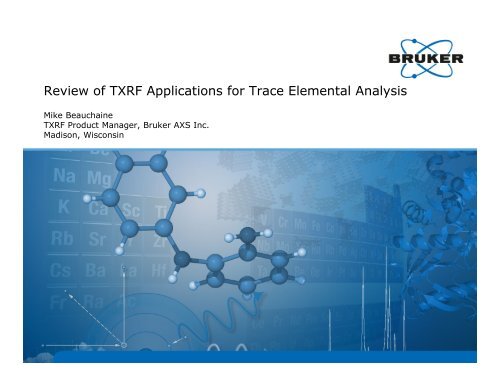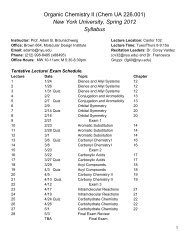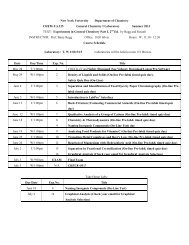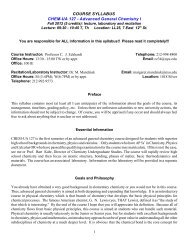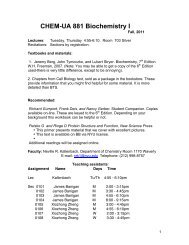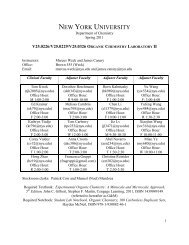Review of TXRF Applications for Trace Elemental Analysis
Review of TXRF Applications for Trace Elemental Analysis
Review of TXRF Applications for Trace Elemental Analysis
Create successful ePaper yourself
Turn your PDF publications into a flip-book with our unique Google optimized e-Paper software.
<strong>Review</strong> <strong>of</strong> <strong>TXRF</strong> <strong>Applications</strong> <strong>for</strong> <strong>Trace</strong> <strong>Elemental</strong> <strong>Analysis</strong><br />
Mike Beauchaine<br />
<strong>TXRF</strong> Product Manager, Bruker AXS Inc.<br />
Madison, Wisconsin
Principles X-ray fluorescence (XRF)<br />
spectroscopy<br />
1<br />
2<br />
3 1. An X-ray quantum hits an inner<br />
shell electron in a (sample)<br />
atom. The electron is removed<br />
leaving the atom in an excited<br />
state<br />
2. The missing inner shell electron<br />
is replaced by an electron from<br />
an outer shell<br />
3. The energy difference between<br />
the inner and outer shell is<br />
balanced by the emission <strong>of</strong> a<br />
photon (X-ray fluorescence<br />
radiation)
Principles X-ray fluorescence (XRF)<br />
spectroscopy<br />
• The energy, and there<strong>for</strong>e the wavelength, <strong>of</strong> the X-ray<br />
fluorescence radiation is characteristic <strong>for</strong> the different<br />
chemical elements.<br />
QUALITATIVE ANALYSIS<br />
• The intensity <strong>of</strong> the X-ray fluorescence radiation is, in first<br />
approximation, proportional to the element concentration.<br />
QUANTITATIVE ANALYSIS<br />
Low Z High Z
Principles <strong>of</strong> X-ray fluorescence (XRF)<br />
spectroscopy<br />
Each element shows a specific line<br />
pattern in a spectrum depending on<br />
the orbitals involved<br />
LK transition = Kα line<br />
MK transition = Kβ line<br />
ML transition = Lα line<br />
NL transition = Lβ line
Principles <strong>of</strong> ED X-ray fluorescence (ED-<br />
XRF) spectroscopy
Principles <strong>of</strong> ED X-ray fluorescence (ED-<br />
XRF) spectroscopy
Principles <strong>of</strong> WD X-ray fluorescence (WD-<br />
XRF) spectroscopy
Principles <strong>of</strong> WD X-ray fluorescence (WD-<br />
XRF) spectroscopy
Principles <strong>of</strong> total reflection X-ray<br />
fluorescence spectroscopy<br />
Quantification in common X-ray fluorescence spectroscopy<br />
absorption <strong>of</strong> primary beam<br />
and fluorescence radiation<br />
secondary fluorescence<br />
enhancement<br />
Ii = f (ci, cj) and ci = f (Ii, cj)
Principles <strong>of</strong> total reflection X-ray<br />
fluorescence (<strong>TXRF</strong>) spectroscopy<br />
Total reflection X-ray fluorescence spectroscopy<br />
monochromator<br />
X-ray tube<br />
detector<br />
sample disc<br />
• Samples must be prepared on a reflective media<br />
• Polished quartz glass or polyacrylic glass disc<br />
• Dried to a thin layer, or as a thin film or microparticle<br />
Beam angle: 0 o / 90 o
Principles <strong>of</strong> total reflection X-ray<br />
Quantification<br />
C<br />
i<br />
=<br />
C<br />
IS<br />
⋅<br />
N<br />
N<br />
IS<br />
C i: Element concentration<br />
i<br />
⋅<br />
⋅<br />
S<br />
S<br />
i<br />
IS<br />
C IS: Internal standard concentration<br />
N i: Element net countrate<br />
N IS: Internal standard net countrate<br />
S i: Element sensitivity factor<br />
S IS: Internal standard sensitivity factor
Principles <strong>of</strong> total reflection X-ray<br />
fluorescence spectroscopy<br />
In <strong>TXRF</strong> the samples are prepared<br />
as thin films or layers<br />
Matrix effects are negligible<br />
Quantification is possible
Principles <strong>of</strong> total reflection X-ray<br />
fluorescence spectroscopy<br />
In <strong>TXRF</strong> the samples are prepared<br />
as thin films or layers<br />
Matrix effects are negligible<br />
Quantification is possible<br />
• <strong>TXRF</strong> detects elements from Na(11)<br />
to U(92)<br />
• The element sensitivities depend on<br />
the atomic number<br />
• The sensitivity factors are calibrated<br />
ex works<br />
• Quantification requires the addition<br />
<strong>of</strong> one standard element<br />
K-lines<br />
Element sensitivity<br />
L-lines<br />
Atomic number
Principles <strong>of</strong> total reflection X-ray<br />
fluorescence spectroscopy<br />
Samples <strong>for</strong> <strong>TXRF</strong><br />
• Powders: Direct preparation<br />
or as suspension<br />
• Liquids: Direct preparation<br />
• Always as a thin film, micro fragment or<br />
suspension <strong>of</strong> a powder<br />
• Necessary sample amount:<br />
Low µg respectively µl range<br />
Simple quantification<br />
Matrix effects are negligible<br />
due to thin layer<br />
Quantification is possible by internal<br />
standardization
Elements measured by the Mo PICOFOX
Elements measured by the W PICOFOX
<strong>TXRF</strong> Spectrum<br />
Multi-element standard
Typical <strong>TXRF</strong> Results<br />
Multi-element standard<br />
Element Conc./(mg/l) LLD/(mg/l)<br />
Ca 0.991 0.003<br />
Ti 0.997 0.003<br />
V 0.986 0.002<br />
Cr 0.994 0.002<br />
Mn 1.015 0.002<br />
Fe 0.996 0.001<br />
Co 1.006 0.001<br />
Ni 1.005 0.001<br />
Cu 1 0.001<br />
Zn 0.989 0.001<br />
As 1.019 0<br />
Se 1.1 0<br />
Sr 0.987 0
The instrument - S2 PICOFOX<br />
Benchtop <strong>TXRF</strong> Spectrometer<br />
S2 Pic<strong>of</strong>ox<br />
Metal ceramic X-ray tube<br />
Mo or W anode<br />
Air cooled<br />
Multilayer Monochromator<br />
Xflash ® silicon drift detector<br />
Electro-thermally cooled<br />
≤149 eV @ MnKα 100 kcps<br />
Automatic Version<br />
25 sample cassette changer
<strong>Review</strong> <strong>of</strong> <strong>TXRF</strong> <strong>Applications</strong>
Current research areas<br />
Environmental /<br />
Ecology<br />
Clinical Research /<br />
Biology<br />
Nanoparticles Food/Beverage<br />
Forensics Semiconductor<br />
Pharmaceutical/<br />
Nutraceutical<br />
University<br />
Research
Sample preparation<br />
Liquid and digested samples<br />
You‘ll need just a few steps <strong>for</strong> the preparation <strong>of</strong> liquid samples<br />
fill sample in micro tube<br />
add internal standard<br />
homogenize<br />
Note: high matrix samples pipette on carrier<br />
may require a dilution step
Sample preparation<br />
Final steps<br />
dry by heat / vacuum<br />
load the instrument<br />
start data aquisition
Liquid Samples<br />
<strong>Trace</strong> Element <strong>Analysis</strong> in Serum & Blood<br />
Measurements and sample preparation<br />
Blood Serum<br />
Dilution, Ultrapure water<br />
Int. Standard, Ga<br />
<strong>TXRF</strong><br />
Whole Blood<br />
Digestion, 10%<br />
tetramethylammonium<br />
hydroxide @ 1 hr<br />
Dilute in 2% HCl<br />
solution
Liquid Samples<br />
<strong>Trace</strong> Element <strong>Analysis</strong> in Serum & Blood<br />
• Comparison <strong>of</strong> <strong>TXRF</strong> to ICP-MS reference values <strong>for</strong> trace elements in<br />
whole blood<br />
• Good concordance <strong>of</strong> <strong>TXRF</strong> with reference values <strong>for</strong> essential elements<br />
• Other elements (P, S, Cl, K, Ca, Br, Rb, Sr) could also be determined<br />
during One measurement<br />
• Samples analyzed at 600s
Liquid Samples<br />
<strong>Trace</strong> Element <strong>Analysis</strong> in Serum & Blood<br />
• Comparison <strong>of</strong> <strong>TXRF</strong> and AAS reference values in blood serum<br />
• <strong>TXRF</strong> has better standard deviations compared to AAS<br />
• No Digestion procedure was applied<br />
• Samples analyzed at 600s
Application studies<br />
Sample preparation <strong>for</strong> solids<br />
Sample preparation <strong>of</strong><br />
plants, tissues, grains<br />
Solid materials are ground to fine particle size<br />
and resuspended <strong>for</strong> direct analysis without<br />
digestion<br />
fill powder in mortar<br />
grind carefully<br />
weigh about 20-50 mg<br />
transfer to tube
Application studies<br />
Sample preparation <strong>for</strong> solids<br />
suspend in detergent solution<br />
add standard<br />
homogenize<br />
pipette on carrier
Application studies<br />
Sample preparation <strong>for</strong> solids<br />
dry by heat / vacuum<br />
load the instrument<br />
start data aquisition
Application Studies<br />
Wheat Flour<br />
Source<br />
Announcement <strong>of</strong> the<br />
Federal Reserve Bank Of<br />
Minneapolis<br />
Sales price <strong>for</strong> Se-poor wheat: < 3 US$/bushel<br />
Sales price <strong>for</strong> Se-rich wheat: < 10 – 15 US$/bushel
Application studies<br />
Wheat Flour<br />
Demand <strong>for</strong> on-site analysis<br />
<strong>of</strong> Se in wheat<br />
Requirements<br />
Fast and easy sample<br />
preparation<br />
Rugged equipment with<br />
no need <strong>for</strong> external<br />
media<br />
High sensitivity/accuracy
Application studies<br />
Wheat Flour<br />
Results<br />
element<br />
concentrations<br />
Reference Values (mg/kg)<br />
10000<br />
1000<br />
100<br />
10<br />
1<br />
0<br />
Se<br />
Ni<br />
Zn<br />
Cu Br<br />
Ba<br />
Rb<br />
Mn<br />
0 1 10 100 1000 10000<br />
Fe<br />
Ca<br />
<strong>TXRF</strong> Values (mg/kg)<br />
Cl<br />
P<br />
S<br />
K
Application studies<br />
Wheat Flour<br />
Results<br />
element<br />
concentrations<br />
Reference Values (mg/kg)<br />
10000<br />
1000<br />
100<br />
<strong>TXRF</strong>-value: 1.40 ± 0.03 mg/kg<br />
Reference: 1.23 ± 0.90 mg/kg<br />
3σ LLD: 60 µg/kg<br />
10<br />
1<br />
0<br />
Se<br />
Ni<br />
Zn<br />
Cu Br<br />
Ba<br />
Rb<br />
Mn<br />
0 1 10 100 1000 10000<br />
Fe<br />
Ca<br />
<strong>TXRF</strong> Values (mg/kg)<br />
Cl<br />
P<br />
S<br />
K
Application studies<br />
Palladium <strong>Analysis</strong><br />
Introduction:<br />
• Palladium is extensively used in pharmaceutical small molecule drug<br />
processes as a catalyst<br />
• It must be removed prior to release <strong>of</strong> the API<br />
• Looking <strong>for</strong> an easy to use technique with fast sample prep and little to no<br />
consumables that can be implemented on the manufacturing floor<br />
Study:<br />
• 6 separate pharmaceutical drugs<br />
• Standards<br />
• Determine linearity, sensitivity, accuracy, and precision <strong>for</strong> Pd plus Cr, Fe,<br />
Cu, Rh, and Pt<br />
• Compare <strong>TXRF</strong> vs. ICP-MS instrumentation<br />
14.02.2012
Application studies<br />
Palladium <strong>Analysis</strong><br />
• <strong>TXRF</strong> Solid Samples Preparation<br />
5 – 10 mg<br />
<strong>of</strong> Sample<br />
14.02.2012<br />
Diluent Choice<br />
Internal<br />
Standard(s)<br />
Sample Prepared in<br />
Organic Solvent /<br />
Dilute Acid Diluent<br />
Sample Solution<br />
Spotted<br />
and Dried<br />
on Substrate<br />
Detector<br />
Sample<br />
<strong>TXRF</strong><br />
Sample Spot<br />
<strong>Analysis</strong>
Application studies<br />
Palladium <strong>Analysis</strong><br />
Conclusion<br />
o The choice <strong>of</strong> the X-ray target is very important <strong>for</strong> Pd<br />
analysis because <strong>of</strong> the Pd-L line interferes with Ar-K line<br />
o <strong>TXRF</strong> can accept organic solvent-based diluents<br />
o Instrument is easy enough <strong>for</strong> a technician to be able to run<br />
samples at or near the plant floor<br />
o Also allows <strong>for</strong> fast analysis <strong>of</strong> impurities with small sample<br />
size requirements<br />
Acknowledgments: Bradley Shaw, David Semin, et.al Analytical and Research Development, Amgen Inc.<br />
Thousand Oaks, CA “Comparison <strong>of</strong> Total Reflection X-Ray Fluorescence (<strong>TXRF</strong>) to Inductively-Coupled<br />
Plasma Spectrometry (ICP-MS): Applicability <strong>of</strong> <strong>TXRF</strong> <strong>for</strong> Open-access<br />
14.02.2012
Sample preparation<br />
Microparticles<br />
Microparticles are measured semi-quantitatively and<br />
non-destructively<br />
dab vacuum grease on carrier<br />
pick-up some particles with a (glass) rod<br />
drop particles on grease
Particles<br />
Characterization <strong>of</strong> nanoparticles<br />
Analytical question<br />
element ratios in CdSe nanoparticles<br />
coated with ZnS<br />
Analytical issues<br />
extremely small sample amount (R&D)<br />
non-destructive method preferred<br />
<strong>TXRF</strong> measurement<br />
transfer <strong>of</strong> nanoparticles to quartz carrier<br />
by cotton bud<br />
standardless quantification<br />
Results<br />
even smallest sample amounts allow the<br />
determination <strong>of</strong> element ratios in<br />
nanoparticles
Particles<br />
Characterization <strong>of</strong> nanoparticles<br />
Results<br />
even smallest sample<br />
amounts allow the<br />
determination <strong>of</strong><br />
element ratios in<br />
nanoparticles<br />
S2 PICOFOX<br />
“Standardless”<br />
analysis applied<br />
Ratio (wt.-%)<br />
12<br />
10<br />
8<br />
6<br />
4<br />
2<br />
0<br />
10<br />
Element ratios <strong>of</strong> nanoparticles<br />
1<br />
Zn/S Cd/Se Zn/Cd<br />
Measured ratios <strong>of</strong> 3 samples<br />
versus target value ()<br />
4<br />
Sample 1<br />
Sample 2<br />
Sample 3
Application Examples<br />
Conclusion<br />
Accuracies and Sensitivities comparable to AAS or ICP without the need <strong>for</strong><br />
complex and time-consuming sample preparation and instrument calibration<br />
• Ability to analyze minute<br />
samples<br />
• Allows <strong>for</strong> analysis <strong>of</strong> toxic<br />
and nutritious elements at<br />
very low levels<br />
• Virtually any sample is<br />
possible with limited<br />
sample prep (powders,<br />
nanoparticles, liquids, thin<br />
films, etc.)<br />
• Elements Na to U within one<br />
measurement<br />
• Detection limits <strong>of</strong> 1 to 100 ppb<br />
<strong>for</strong> most elements
© Copyright Bruker Corporation. All rights reserved.<br />
www.bruker.com


